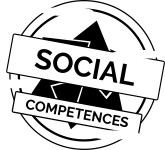Six thinking hats
This tool encourages a group to look at a situation from a new angle. Each 'hat' represents a different way of looking at something. There are a number of ways to do this exercise. For example, individuals within the group can wear different hats whilst the group discusses an issue. Another alternative is that everyone in the group can try on one of the 'thinking hats' for a while, and then everyone can put on another one.Six Thinking Hats is an effective tool to use for individual thinking.
Target group
- Teenagers (cca. 13 – 18 years)
- Young adults (cca. 17 – 26 years)
- NEETs
- Youth with fewer opportunities
- Youth workers
- Teachers

Content
Six Thinking Hats is a critical and creative thinking training that helps individuals and organizations throughout the world become more effective, innovative thinkers. Six Thinking Hats is a flexible and easy-to-use thinking process that leads to amazing results with innovative thinking, improved communication, and reduced meeting time. Six Thinking Hats puts everyone in meetings on an equal playing field, keeps egos in check, depersonalizes criticism, and creates an open environment that encourages the unique contributions of each individual, even those who are typically more reserved.
Skills:
- Leadership Development
- Communication
- Creative and innovative thinking
- decision making
- Critical, Analytical Thinking and Problem-Solving
The method can be used also for other content.
Materials
different kind of hats, paper, pencilsSpecific Environment
school class, play groundSpecific goals
Raising the level of skills that are useful/helpful for youth to their social involvement/participation ( such as self-confidence, leadership, …); Advise young people how to identify, diagnose or just name challenges and problems of their social environment; Advise young people how to put their entrepreneurial ideas into social practice (e.g. presentation of project methodology, strategical planning, etc.)Description
Each of the Six Thinking Hats represents a different direction or type of thinking, which is identified by a colour:
- White hat: White-hatted people concentrate on the facts – what information and knowledge do you know about the situation? What can you learn about the situation from this information? What info is missing? Can you plug the gap? If not can you take it into account when discussing the situation? What can you learn from past trends?
- Green hat: Green hat people think creatively in a no-criticism, freeform thinking kind of way.
- Red hat: Red hats are the emotional input of the discussion. They allow themselves to be intuitive and act as much on hunches as fact. They are sensitive to the emotional responses of others in the group.
- Black hat: Black hats live under a black cloud! They should think pessimistically. Look for the flaws in the plan, find the obstacles!
- Yellow hat: Yellow hats bask in sunlight – they should think positively looking for the value in every possibility. What benefits does it bring?
- Blue hat: The blue hat is worn by the facilitator(s). They concentrate on process, calling on the other hats to add in their thinking as and when it's appropriate and making sure that each option is scrutinised from all perspectives. They are neutral, helping the group achieve its task without trying to shape the decision.
Everyone focuses on the same type of thinking at the same time (parallel thinking), which minimizes conflict and promotes progress. When switching hats, everyone changes to the different mode of thinking to tap into their collective knowledge. This eliminates egos and has the potential to dramatically reduce the amount of time spent in meetings.
Just one hat may be used (“What's your red hat on this issue?”), or a combination of the Six Thinking Hats may be used in a particular sequence to examine an issue.
Outcomes and its measurability
This tool actively seeks out the optimistic analysis, the pessimistic analysis etc., so every idea is thoroughly tested, and when the decision is made, it's made on the basis of a creative and thorough process.



